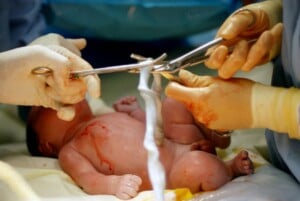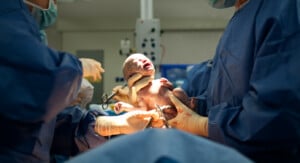Childbirth can feel like heading into the great unknown. There are so many options, preferences, and expectations to consider. Birth positions, pain management, medical interventions, skin-to-skin, enemas, and the seemingly inevitable perineal tear. What if I have a 1st-degree perineal tear, 2nd-degree perineal tear, 3rd-degree perineal tear, or even a 4th-degree perineal tear?
The most common question I receive next to pooping during labor is, what happens if I tear? Perineal tears are a normal worry and an expected outcome of vaginal deliveries. Up to 90% of women will experience some degree of perineal tearing or laceration. Below, we will answer all your questions about perineal tears during delivery so you know what to expect.1
What is a Perineal Tear?
Your body starts preparing for delivery in early pregnancy. Hormonal changes result in increased blood flow to your vagina, which can cause swelling, softening, and elasticity of the inside tissues. You may experience a difference in vaginal discharge. The microbiome of your vagina also changes to ensure a suitable environment for your developing baby.5,6
The delivery of a baby causes a great deal of stress on the tissues of the cervix, vagina, vulva, and perineum. Your perineum is the area of skin, mucosal tissue, and muscle between your vagina and vulva and the anus and rectum. It is the most frequent place where tears or lacerations occur during vaginal delivery.1
As you bravely push your newborn into the outside world, your body does its best to stretch and accommodate the head and body of your little one. A tear occurs when the tissues give way, as they often do.
What Causes a Perineal Tear?
Perineal tears occur for a few reasons, a couple of which are beyond our control:1
- First vaginal delivery
- Large baby
- Rapid delivery
- Episiotomy
Despite your best efforts to prevent tearing during delivery, it is not so easily avoidable. But do not be dismayed. Your work to avoid tearing may decrease the severity of a laceration and aid in a seamless healing process.
Risk Factors for Perineal Tears
There are additional risk factors that may increase your chance of tearing during delivery:1,4
- Forceps or vacuum-assisted delivery
- Fetal presentation. A “sunny side up” presentation is called an occiput posterior position or a compound hand position where your baby has a hand or arm alongside its head.
- Episiotomy. Though not routinely used in the United States, an episiotomy may be warranted in fetal distress.
- Prolonged pushing
- Asian descent
Four degrees of perineal tearing
The perineal area is full of muscles and soft tissue that provide stability and function to your pelvic floor. Perineal tears are classified by their degree of injury to the structures of the perineum:1,4
- 1st-degree tear: As the least severe tear, this laceration involves the first layer of vaginal tissue and perineal skin.
- 2nd-degree tear: This most common laceration extends deeper into the vaginal tissue and the perineum muscles.
- 3rd-degree tear: This tear extends deep through the perineum muscles to involve your anal sphincter. The sphincter muscles surround your anus, helping you to control your bowel movements.
- 4th-degree tear: The most severe laceration extends through the anal sphincter muscles into the rectal mucosa.
Tearing in Other Places
It is possible to tear in other places aside from your perineum. For example:
- Your vaginal wall and labia are susceptible, especially if your baby’s hands are near their face during their exit.1,3,8
- Cervical tears, though uncommon, can occur and often require surgical repair. Lacerations around the urethra and clitoris may also occur.1,9,10
How Are Perineal Tears Treated
Thankfully, not all injuries to your perineum will require stitches. You may hear your obstetrician or midwife refer to “skid-marks,” especially if it’s not your first delivery rodeo. “Skid -marks” are scratches or cuts that do not require stitching. They only need time to heal and attentive perineal care, much like a scraped knee.
Most degreed tears will require repair with dissolvable sutures or stitches. Tears are repaired as quickly as possible to control bleeding. A local anesthetic such as lidocaine may be superficially injected into the torn tissue for pain control during the repair. If you have an epidural, pain-relieving medication will continue to flow while your tear is fixed. Tissue layers are sutured one at a time, with skin-to-skin being the final layer.1
Your healthcare team will review the basics of perineal care with you, including a peri-bottle, an endless supply of sanitary pads, and, perhaps, disposable undies.
Complications of a Perineal Tear
Complications of a perineal tear can include pain and infection. Here are the most common complications.
Pain: The Most Common Complaint
Perineal pain is an unfortunate and annoying expectation while healing from a tear. Though this discomfort should not last long, here are some suggestions that may help:7
- Rest. We know this is hard, but so crucial in the days following delivery.
- Sitz baths
- Pour water over the area. Those peri-bottles are great for keeping clean and avoiding more abrasive toilet paper.
- Use of stool softeners
- Ice packs or padsicles
- Analgesic creams or spray
- Over-the-counter pain medications
In a few days, the pain will subside and be replaced with soreness and possibly itching as the tissues heal. Speak with your healthcare provider if your pain is significant. Extreme discomfort could indicate more severe complications.
Other Complications of a Perineal Tear
Perineal tears, especially third and fourth-degree lacerations, can potentially cause postpartum complications. Some physical complications include:3
- Wound infection
- Wound separation or dehiscence
- Bowel incontinence
- Urinary incontinence
- Sexual dysfunction
Healthy sexual activity contributes to overall well-being. Wait for the go-ahead to resume sexual activities from your obstetric provider. If you are experiencing discomfort and pain during sex, or are experiencing incontinence, speak with your provider about your concerns.
Perineal tears are a significant concern for many, but you will heal with prudent care and rest. Want the good news? Even if you experience a 1st-degree, 2nd-degree, 3rd-degree, or 4th-degree perineal tear during your first delivery, your risk of tearing a second time is significantly reduced.






























